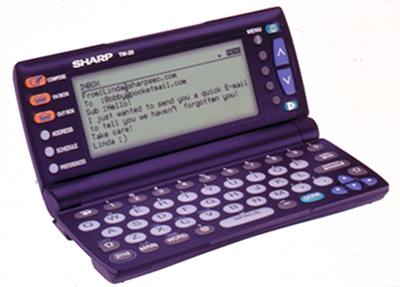E-mail on the Move
Check your pocket...you've got mail! Technology originally developed at NASA now lets users send and receive electronic mail (e-mail) through regular or cellular telephones using a small, hand-held unit.
PocketScience™ Inc., of Santa Clara, California, is a privately held company founded in 1995, aimed at making mobile e-mail service not only affordable, but easy to use. The company is pursuing its mission by melding key technologies, expertise in consumer electronics and electronic messaging, and strategic partnerships. At its inception, PocketScience™ was a member of the NASA Ames Technology Commercialization Center.
A new hand-held device uses technology originally developed at NASA's Jet Propulsion Laboratory. Through its involvement with Ames' Technology Commercialization Center, PocketScience™ was able to use space probe communications technology and adapt it for advanced signal processing on Earth.
The idea behind the technology is to overcome the limitations of current mobile messaging solutions and provide access to e-mail anywhere. PocketScience™ created its first offering, the PocketMail® device. PocketMail® makes it possible to send and receive e-mail from anywhere in the world without turning on a computer. The device gives regular e-mail users a practical alternative to laptop computers and wireless devices when trying to send e-mail on the go. International travelers no longer have to be confronted with the nightmare of incompatible electric systems and telephone jacks while far from their home country. The mobile messaging device also permits the transmission of faxes.
The firm's device operates by holding it against a phone handset and pushing a button. Even under the harshest conditions, the small, 9-ounce portable unit, can send and receive e-mail through most phones worldwide, including cellular, cordless, Integrated Services Digital Network (ISDN), office and hotel PBX phones, and pay phones. In airport terminals, on busy street corners, and in other noisy locales, the device functions by incorporating special modulation schemes, error-correction, data compression, and data communications protocols. The technology is packaged to fit in a shirt pocket, runs on two AA batteries, and is about the size of a calculator. A modest monthly charge, beyond the initial cost of the electronic device, gives users access to e-mail services.
Users of the device compose their message, dial a nationwide toll-free access number, then push one button while holding the device against the telephone handset to send and receive messages. No cables or special connectors are needed. By employing burst packet communications, no lengthy log-on is needed. The entire process usually can be completed in less than a minute.
Electronic mail has been on a spectacular growth curve. Its phenomenal climb as a major communication tool is supported by research surveys. One study suggests the number of e-mail users in the United States alone is expected to grow from 75 million in 1998 to 135 million in 2001. And those users will transmit, in the U.S., as many as 500 billion messages in 2001. Another survey statistic is that Internet users check their e-mail at least once a day, a habit that is on the rise from previous years.
"With e-mail rapidly becoming a preferred way to stay in touch with friends, family, superiors, staff, or clients, it's only natural that people will also want to be able to access and respond to their e-mail while away from their homes and offices," states a corporate background paper developed by PocketScience™.
The first PocketMail®-enabled products have been announced by JVC and Sharp Electronics. Several other U.S. and international consumer electronics manufacturers are currently evaluating PocketMail® technology for inclusion in their next generation of products.
PocketScience™ is a trademark of PocketScience, Inc.
PocketMail® is a registered trademark of PocketScience, Inc.

PocketMail® by PocketScience is a hand-held e-mail device that uses technology originally developed at NASA's Jet Propulsion Laboratory.













